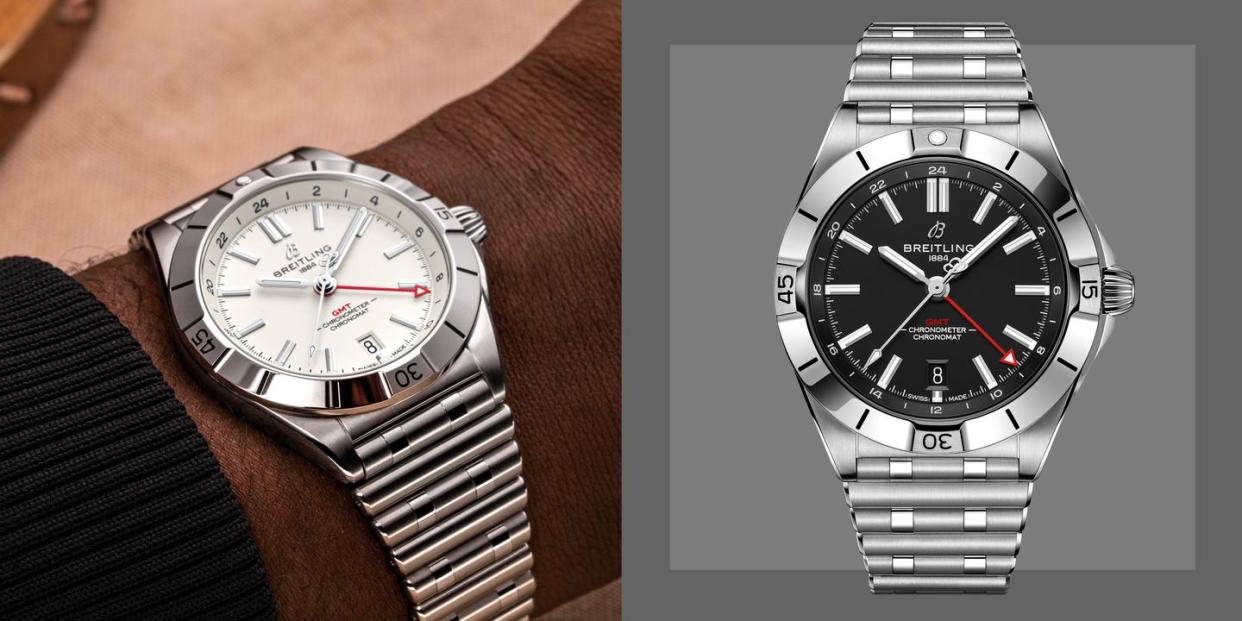Breitling's High-Flying New GMT Is a Travel Essential

If you’ve ever logged on to a plane’s Wi-Fi using your phone or laptop, you know that keeping track of time can get pretty confusing, pretty fast. On a transatlantic flight, for example, as you zoom over Greenland, your phone will update (albeit with occasional lags) to Greenland time. Except you’re not actually in Greenland when you’re at 37,000 feet. Sometimes technology isn’t all it’s cracked up to be. When digital fails you, opt instead for mechanical.
A major addition to Breitling’s successful Chronomat watch line is a brand-new GMT, one of watchmaking’s cleverest and most useful mechanical complications, and one that frees you from digital tyranny while helping you track time. The function was developed to benefit pilots at the dawn of the civil aviation age—around the early 1950s—who needed something to help them keep their heads on straight as they crossed multiple time zones.
Breitling’s new stainless steel Chronomat GMT pitches in at a handy 40mm in size with a simple and elegant display. There’s a distinctive red GMT hand and sunray dials that come in a range of colors—white, green, blue, black, and anthracite—on sporty rouleaux steel bracelets. Previous iterations of the Chronomat, a style that was relaunched in 2020, were a diminutive 36mm three-hand or a beefy 44mm chronograph. The new GMT, which has a chronometer movement (an automatic Breitling Caliber 32 with a power reserve of 42 hours) neatly splits the difference, for a great everyday watch with added functionality.
Now what’s so special about a GMT watch? Well, the capability to tell the time in two different places at a glance is pretty damn nifty. That said, there are two kinds of GMT watches, which, by the nature of their movements, have subtle differences in their use. It’s good to know how they differ. Bear with us; this might be a bit of a mind-bender.
The new Chonomat GMT is an “office” GMT. If you, for example, work in Los Angeles but have a head office in Paris and you want to keep track of the working day at HQ, what you need is what is known as an office or a caller GMT. So, you would use the GMT hand, which circles the dial once in 24 hours, to show you what time it is nine hours ahead in Paris, and the regular hour hand to track time in L.A. So far so good? When you adjust the time in the away zone, the movement’s gearing means the GMT hand can be moved independently of the other hands, so your local time is not affected.
The other type of GMT however, known as a “true GMT” is geared differently and allows you to adjust your local hour hand without affecting the other hands. This is best if you do a lot of traveling, because you can update your local hour as you arrive in a new time zone without changing the time in the away zone. That's helpful if you’re flying from L.A. to London and want to reset your local time, but don’t want to lose track of Paris time when you land. Critically, the date function on a GMT watch is usually pegged to the local hour hand, so the date wheel will keep pace with your time changes overnight. If, in trying to explain this, we haven’t completely lost you, rest assured both types are legitimate GMTs in that they allow for useful timekeeping in two time zones at once.

GMT watches are named after Greenwich Mean Time, the UK’s zero meridian time standard from which the times in the planet’s 23 other time zones are (or were for a long time) derived. This hasn’t always been the case. Until the mid-19th century, though GMT had been a thing for astronomers since the 17th century and for navigators since the 18th, the time was different from one town to the next even in the same country, governed by the moment the sun crossed its particular meridian. In the UK, for example, Bristol Mean Time was ten minutes behind GMT, Cardiff Mean Time another three minutes behind. With such a nebulous system, travelers from one town to the next reset their pocket watches on arrival by referring to the local church bell. Accuracy was not so vital when your mode of transport was a horse.
But with the development of faster and more dependable modes of transport—like railways—a far more reliable standard was needed. The first public clock to display GMT was mounted on the gatehouse of the Royal Observatory in Greenwich in 1852. It displayed, fittingly, like modern GMT watches, a 24 hour scale, with the hour hand making a full revolution in 24 hours rather than 12. As the United States of America adopted Greenwich Mean Time, and the vast majority of shipping charts relied on it too, the impetus to make GMT the global standard became unstoppable. Finally, in 1884, GMT was widely accepted beyond the shores of the UK. There were however a few hold outs. In France, the government adopted Paris Mean time in 1891, eventually shifting it by nine minutes and 27 seconds in 1911 to synch with Greenwich but still (suitably) calling it Paris Mean Time.
You Might Also Like
